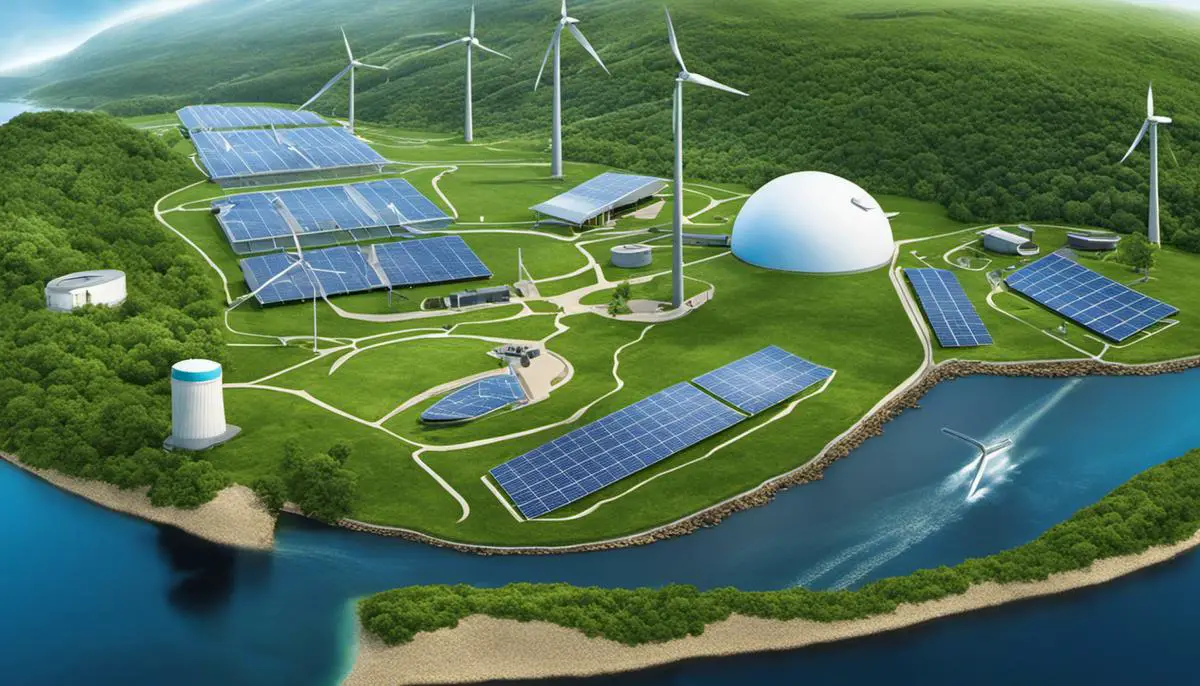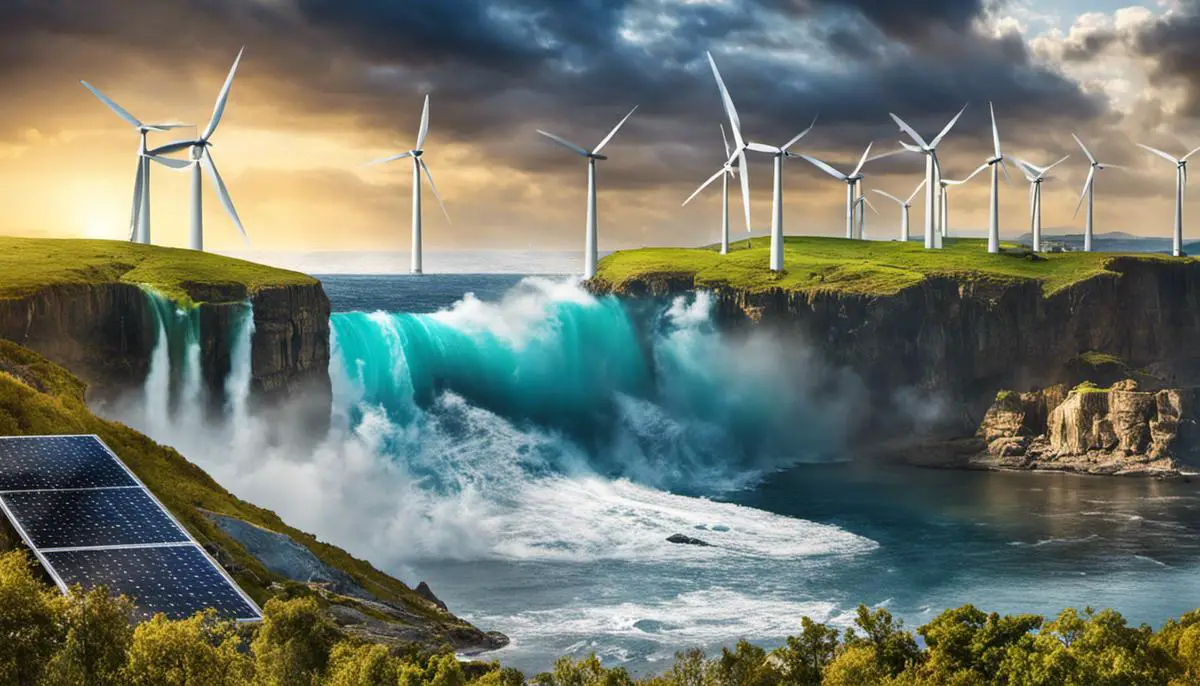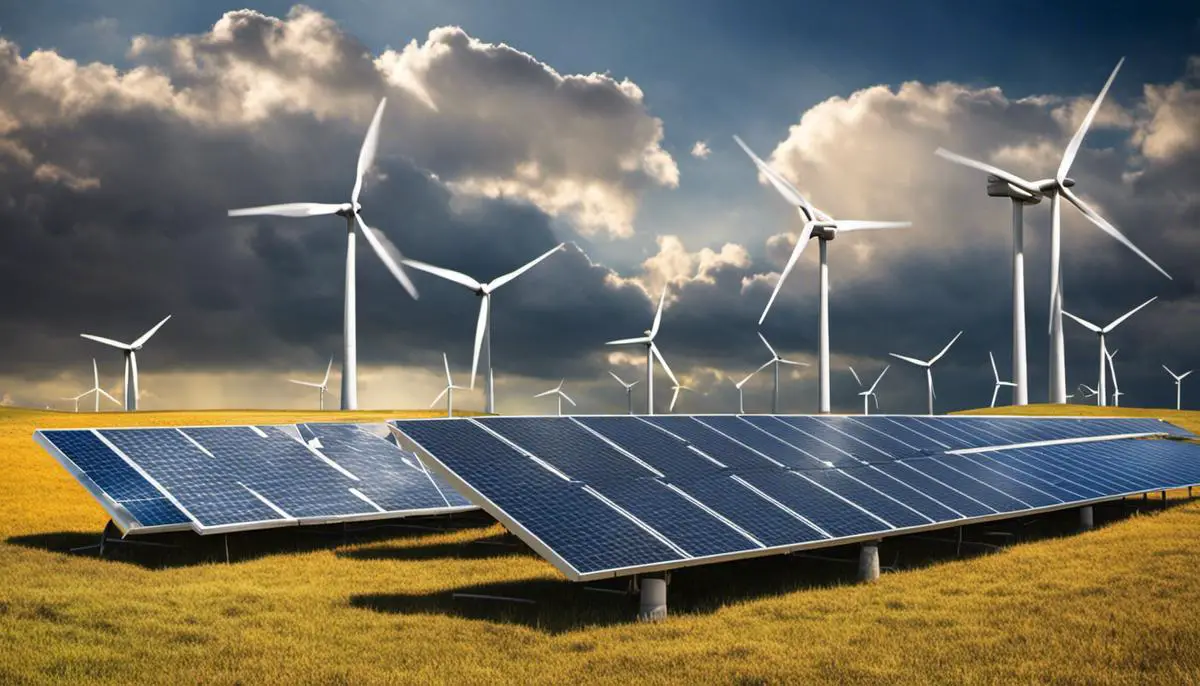Acceptance of alternative energy sources as a desirable route in sustaining the public’s need for electrical energy to power their appliances, gadgets, cars, among others vary across individuals. Let’s explore this issue in this article.
In the wake of escalating environmental concerns and increasing dependence on unsustainable power sources, the turn to alternative energy is more imperative now than ever. These forms of renewable energy that include wind, solar, bioenergy, geothermal, and hydroelectric, are poised to take center stage in the global power generation panorama, promising a sustainable future for mankind.
Understandably, there are certain complex facets associated with the harnessing and acceptance of these sources of energy. Thus, it is vital to shed light on aspects such as the benefits and limitations of these sources, the public’s perception and acceptance, the relevant policies, as well as future prospects of alternative energy.
Table of Contents
Definition and Types of Alternative Energy Sources
Definition of Alternative Energy Sources
In the evolving rubric of scientific advancement, alternative energy sources play an essential role in mitigating the global resurgence of environmental concerns. The terminological precision of ‘alternative energy sources‘ refers to the energy resources that step away from the conventional fossil fuel paradigm, offering an eco-friendly alternative.
Alternative energy sources refers to the energy resources that step away from the conventional fossil fuel paradigm, offering an eco-friendly alternative.
This article endeavors to elaborate on these varied sources of energy, helping to further deepen understanding and foster appreciation for the enormity of this field. Let’s review these renewable energy resources that many people harness to power their homes, appliances, among others.
Types of Alternative Energy Sources
1. Solar energy
Solar energy, harvested from the limitless bounties of the Sun, stands at the forefront of alternative energy sources. Harnessing the Sun’s power via photovoltaic cells or concentrated solar power systems, humanity has tapped into a ceaseless stream of clean energy. Capable of powering anything from small appliances to entire cities, solar energy serves as a vital and ubiquitous alternative energy resource.
2. Wind energy
The field of wind energy, marked by towering turbines capturing the kinetic energy of the wind, has facilitated green-energy initiatives globally. The mechanical energy harnessed is converted into electrical energy, powering homes, industries, and emerging as an indispensable part of the energy grid in multiple nations.
3. Hydropower
Hydropower, while a long-standing source of electricity, remains a crucial alternative energy source. Capitalizing on the kinetic energy of moving water, hydropower plants translate this energy into a functional power supply. The efficiency and reliability of hydroelectric power firmly anchor it in the energy landscape of numerous countries.
4. Geothermal power
Beneath Earth’s surface, geothermal power nests as an underappreciated alternative energy source. Utilizing the Earth’s inherent heat, generated from radioactive decay and stored in geothermal reservoirs, geothermal power plants possess the potential to operate ceaselessly, supplying a consistent power output.
5. Tidal and wave energy
Promising yet nascent, tidal and wave energy sources emerge as sustainable forerunners in the alternative energy panorama. Hinged upon the immense energy potential of Earth’s oceans, tidal and wave energy sources capture, harness and convert the kinetic energy of ocean tides and surface wave motion into electricity.
6. Bioenergy
Another recent sunrise in the alternative energy landscape is bioenergy. This involves harnessing energy from biological matter, including organic waste, agricultural residues, and specially grown energy crops. Thermochemical processes convert this raw biological matter into biofuels, heat, and electricity, ensuring a cyclical, environmentally friendly energy generation process.
The road to alternative energy sources is intriguing, paved with constant scientific innovation and technological breakthroughs. Each type of alternative energy source carries a distinctive set of advantages and challenges, with potential impacts on global power infrastructure, economics, and most crucially, the environment.
As the journey to a sustainable energy future continues, it remains incumbent upon researchers to foster an environment conducive to exploration, discovery, and implementation of these invaluable alternative energy resources.

Benefits and Limitations of Alternative Energy Sources
Alternative energy sources, commonly referred to as renewable energy, provide a means of power that’s much kinder to the environment as compared to traditional fossil fuels. However, each energy source carries its own set of benefits and limitations, whose understanding is critical in making informed decisions towards a sustainable future.
Biomass energy, converted from organic matter, shows promise due to its technical maturity and readiness for use. It offers a closed carbon cycle, as the quantity of carbon dioxide produced during combustion is equivalent to that previously absorbed by the plant.
Furthermore, biomass can be stored, assuring reliability of energy supply. However, biomass cultivation could risk deforestation and agricultural price inflations due to diversion of cropland. The large land footprint required, and lower electric energy production are also hurdles to overcome.
Additionally, one must consider hydrogen and fuel cells as emerging forces in the alternative energy spectrum. Fuel cells are efficient at converting fuel to electricity, thus reducing carbon emissions.
Advancements in technology have improved the overall lifespan of fuel cells, presenting an opportunity for longer-run vehicles. Despite the current expensive costs associated with hydrogen fuel cell system distributions, a promising future beckons as research carries on.
Another interesting alternative is energy harnessed from space, known as space solar power (SSP). SSP has a significant advantage; it circumvents the day-night cycle restriction faced by ground-based solar power. This technology is not yet developed to a profitable or practical level, but it remains a potential prospect for future energy supply, given the exponential growth of technology.
There’s also the potential of tidal power and wave energy. The predictability of tidal streams arguably positions it as a more reliable energy source than wind or solar power. Yet, the design and maintenance of the infrastructure in these harsh marine environments remains complex and cost-prohibitive, posing a significant challenge.
Finally, nuclear fusion provides an abundant source of energy with no carbon emissions. However, despite its vast potential, nuclear fusion is currently not viable due to the technological difficulties of devices that can safely contain the extremely high temperatures necessary for the fusion process.
The benefits and limitations of alternative energy sources are diverse and complex. Each technology requires continuous investment in research and development. It’s important to remember that an effective approach to energy generation and conservation will require not a single solution, but a balanced, multi-faceted approach. Only through continued exploration and innovation can we address the various challenges surrounding alternative energy and march towards a sustainable future.

Public Perception and Acceptance of Alternative Energy
Public Perception and the Evolution of Alternative Energy Sources
As time progresses, it has become increasingly evident that harnessing the inexhaustible power of nature offers promising alternatives to the finite store of fossil fuels. The exploration and innovation in the fields of alternative energy have witnessed monumental advances.
Yet, it is equally important to assess and understand the public’s attitudes towards these emergent energy sources, as public acceptance is fundamental to successful implementation. This analysis will explore these complex attitudes over time, examining factors such as public awareness, knowledge, and acceptance.
Public acceptance of alternative energy sources is fundamental to successful implementation.
Public perception of alternative energy has been shaped by numerous factors over the years, including environmental concerns, economic implications, and technological advancements. Historically, alternative energy was viewed as attractive but impractical, primarily due to economic prohibitions and lack of efficient technology. Public interest was often relegated to theoretical discussions and the confines of scientific experimentation.
Public Acceptance of Alternative Energy Sources
The climate change discourse, however, has propelled alternative energies into the frontline of public consciousness. Concerns about the environment have given rise to a generation more receptive to sustainable practices, including alternative energy implementation. There has been a surge in public acceptance of alternative energy sources, not merely as abstract concepts but as tangible assets in responding to environmental crises.
A notable shift in public opinion occurred in the last two decades, when energy cost became a key factor changing attitudes. As fossil fuel prices soar and technological advancements are making alternative energies cheaper, public acceptance of alternative energy sources has increased exponentially. Today, societies globally view alternative energy as a means to alleviate economic burdens.
Today, societies globally view alternative energy as a means to alleviate economic burdens.
Alternative Sources of Energy as Agents of Socioeconomic Transformation
Furthermore, an emerging trend is the recognition of alternative energy sources as agents of socio-economic transformation. The potential for job creation and local economic stimulation has reinforced support for initiatives like wind farms, solar arrays, and biomass facilities. There is a growing perception that besides mitigating environmental consequences, alternative energy sources could also remedy social disparities.
Knowledge Gaps and Misconceptions
Nevertheless, it’s indispensable to note that knowledge gaps persist, often resulting in fears and misconceptions. Nuclear power, for instance, has been confronted with controversies and public reservations.
Long-held concerns regarding the safety of nuclear power stations and potential radioactive waste management often eclipse the low greenhouse gas emissions it offers. Comprehensive information campaigns are thus crucial to bridge these gaps and align public perception with the scientific community’s consensus.
In conclusion, the journey of public attitudes towards alternative energy has evolved from indifferent curiosity to informed acceptance. The road ahead is replete with challenges and it requires relentless effort to continually improve technology, decrease costs, and ensure public perceptions are rooted in factual information. Throughout this evolution, one thing remains clear – sustained public support is an integral part of the enduring transition towards sustainable sources of energy.

Policies and Research on Alternative Energy
The Evolution of Energy Storage
Energy storage is an area of substantial progress in contemporary alternative energy discourse. This amendment has led to revolutionary rechargeable battery innovations, particularly lithium-ion batteries renowned for their high power and energy densities. These have been indispensable in electric vehicles and renewable grid storage, substantially catalyzing the adoption of alternative energy.
Notably, research laboratories are fervent on expanding beyond lithium, exploring sodium-ion, aluminum-ion, and magnesium-ion batteries to ensure sustainability and efficiency.
Exigency of Novel Policies for Environmental Control
With the expansion of alternative energy sources, there is an imminent challenge of environmental regulation. It calls for the evolution of existing policies that are in pace with technology deployment.
Case in point, strategies should be implemented to control the environmental damage during the extraction of lithium or rare-earth elements used in the alternative energy industry. Moreover, policies should be enacted to maintain ethical standards in material sourcing and waste management to ensure a truly sustainable energy sector.
Advancements in Energy Distribution and Management
An area where breakthrough and innovation are paramount is the realm of energy distribution and management. Grid modernization, especially the development of smart grids, is critical in this aspect. These grids integrate digital computational power and sensor advancements to dynamically manage the creation, distribution, and consumption of electricity, thereby enabling increased efficiency and reliability. Fusion of these grids with renewable energy resources, storage devices, and end-use consumers into a seamless, responsive system are areas of concentration in ongoing research.
New Horizons: Exploration of Less Conventional Sources
Intriguing developments are noticed in the harnessing of less conventional energy sources. Groundbreaking researches amplify the value proposition of capturing energy from human movements, biomedical applications, and harnessing thermoelectric power – converting waste heat into electricity. There is much anticipation built around these emerging paradigms in the energy landscape.
Research on Carbon Capture, Utilization, and Storage (CCUS)
CCUS is a prominent column in the climate-resilience fortress. It is the process of capturing carbon dioxide released from power plants and industrial processes, converting it into a form for secure storage or reuse.
Besides mitigating climate change, CCUS can aid in offering a reliable, low-carbon power supply. It addresses the need for carbon-neutral power generation and thus acts as an enabler of green, sustainable growth.
The Pathway to Renewable Hydrogen
Another intriguing development in alternative energy sources is renewable hydrogen. Being colorless, tasteless, and highly energy-rich, hydrogen offers colossal potential for clean energy.
The concept of ‘green hydrogen’, produced from water using renewable electricity, is gaining momentum. The focus is on the efficiency and economics of electrolyzers, improvements in hydrogen storage and distribution, and the developments leading to a broad uptake of hydrogen across multiple sectors.
The current analysis paints the sight of a world rife with inventions and adaptations remolding the panorama of alternative energy. The scale of complexity is staggering, as is the magnitude of potential benefits. It is indeed a promising peak into the imminent, brighter future of earth’s energy narrative.

Future Prospects of Alternative Energy
Nanotechnology
The future of alternative energy rests on exploring uncharted territories and refining our established practices. One such promising territory is the application of nanotechnology in the field of renewable energy.
Nanotechnology’s entrance into the energy sector could revolutionize material performance, establish highly enhanced capacity for energy storage, and pioneer new ways of improving the efficiency of energy systems. Through advancements in the manipulation of material properties at the atomic level, nanotechnology holds the potential to codify a new frontier in alternative energy sector.
Artificial photosynthesis
Advancements in artificial photosynthesis also hold an exciting promise for the future of alternative energy. Using sunlight to split water into hydrogen and oxygen, replicates the natural process of photosynthesis, with hydrogen being a potential clean burning fuel. This clean technology presents a glimpse into a sustainable future where energy production aligns harmoniously with the natural world.
The importance of policy in defining the direction of alternative energy
In tandem with leaps forward in technology, the role of policy continues to mold the trajectory of alternative energy sources. Forward-thinking policy that values sustainability can stimulate innovation, like in the case of renewable energy microgrids. These decentralized systems, capable of functioning independently from traditional energy grids, can increase autonomy and resilience among communities and regions. Progressive policies supporting such systems are a colossal stride towards a securer, decentralized energy future.
Circular economy
Circular economy is another catalytic influence that could shape the alternative energy sector. Here, waste is reconceptualized as a resource, harnessing unused or spent energy to bolster efficiency.
For example, the use of waste heat from power plants to heat homes and businesses is a possible trajectory under the concept of a circular economy. This appeals to the principle of economy in usage and sustainability and might significantly contribute to future energy solutions.
Climate change as a problem that requires innovative solutions
The pressing necessity to confront climate change fuels innovation into large-scale carbon dioxide removal techniques. With technologies like direct air capture coming to fruition, these could provide a foundation for future power stations. By removing carbon dioxide directly from the ambient air and converting it into combustible fuels, we lay groundwork for an intriguing path in the executive suite of clean energy solutions.
Energy from microbiological sources
The exploration into energy harvesting from microbiological sources offers an extraordinary potential pathway within the alternative energy sector. Harnessing the capabilities of microorganisms to generate electricity, known as microbial fuel cells, could provide a sustainable solution to both energy and waste issues faced by human society. The potential of microbial fuel cells, although not entirely understood, indicates a stimulating new venue in the realm of alternative energy.
Summing It All Up
The trajectory of alternative energy sources in the future resides in diversity, at an academic level, a technological level, and a policy level. Incorporating multidimensional approaches to tackling the multifaceted crisis of climate change, will undeniably play a crucial role in the welcoming of a sustainable, resilient era energized by cleaner and greener alternative sources. The journey into the future of alternative energy comprises both the expansion of established ideas and the exploration of novel concepts, always keeping the spirit of innovation alive.
In the cornerstone of this transformative era, the journey towards a sustainable future replete with clean, green, and abundant power lies in the heart of alternative energy sources. Indeed, there are challenges to be addressed and obstacles to be overcome, from cost to geographical constraints and public perception.
Nonetheless, with continuous research driving innovations, along with supportive policies, the sails of the human race are set towards a viable and resilient energy ecosystem. The future of these renewable energy sources is not only promising but is intrinsically linked with the very survival and prosperity of Earth and its inhabitants. Thus, the key to a cleaner, greener, and more sustainable planet lies firmly with alternative energy sources.


